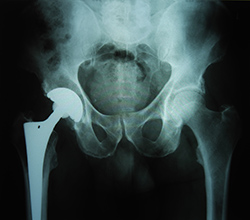
Traditional hip surgery involves making a 20-30 cm incision over the hip, the muscles are split or detached from the hip and the hip is dislocated. This is done so the surgeon can remove the ball joint and insert a metal implant into the femur.
Minimally invasive total hip replacement allows the surgeon to perform the hip replacement through one or two 10 cm incisions. The surgical procedure is similar but there is less dissection of the muscle and soft tissue. As a result the following benefits of minimally invasive total hip replacement have been reported:
- Patients tend to have less pain
- Patients rehabilitation after surgery is faster
- There is less muscle damage
- Patients are discharged from hospital after 1 or 2 days versus 4 to 5 days with traditional hip surgery
This surgical approach is not advocated for patients who are obese, have osteoporosis, or who have severe bone deformities.
In order to gain access to the hip (operative site) the patient needs to be positioned on a suitable dedicated orthopaedic table like the STERIS OT 1000 for example.
Reference
NICE guideline, Minimally invasive total hip replacement, 2012
https://www.nice.org.uk/guidance/IPG363
